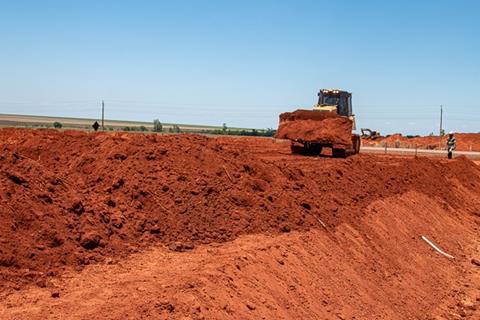
BRAZIL: Construction work has begun on the 730 km railway from Rondonópolis to the Mato Grosso state capital of Cuiabá, Nova Mutum and Lucas do Rio Verde, which is being developed by Rumo Logística as an extension to its Malha Norte network.
The rail and logistics operator was awarded a licence to build the first stage of the line on June 14 this year, having been given a contract for the project on September 20 2021. The official start of work on the Y-shaped route was marked by a ceremony in Rondonópolis on November 7, attended by Federal Minister of Infrastructure Marcelo Sampaio, Mato Grosso Governor Mauro Mendes and Rondonópolis Mayor José Carlos do Pátio.
The project is structured as a public-private partnership and is regarded as a Mato Grosso state project, being authorised under the state’s ‘complementary law’ 685/2021. An environmental impact study prepared by engineering and management consultancy STCP had earlier been approved by the Mato Grosso State Secretary for the Environment. Construction is expected to take no more than eight years.
One of the first tasks for the initial 8∙6 km section of the line is to build a 110 m long bridge over a section of the BR163 federal highway. After this, the railway will continue for 35 km to the Rio Vermelho, where a 1 km viaduct will be needed to carry the line across the river. In total there will be 22 bridges and 21 viaducts, together with 2 km of tunnels. There will also be 155 dedicated crossings for fauna. The line will pass through 27 municipalities.
Construction teams are expected to reach Cuiabá around the middle of this decade, with 2028 set as the target date for reaching Lucas do Rio Verde. Traffic over the new line is expected to be predominantly agricultural produce, much of which will continue from Rondonópolis over Rumo’s existing network to the port of Santos.
Job creation

Noting that the work would not have started without the efforts of the Mato Grosso state government, Rumo Chief Executive Officer Joao Alberto Fernandez de Abreu put the estimated cost of the project at R$11∙2bn. He said work would proceed from four construction bases, generating around 100 000 jobs directly and a further 100 000 related employment opportunities.
Sampaio praised local politicians for their initiative in passing legislation that paved the way for the new railway to be built. He believed that the project would attract development in the state and suggested that the formula adopted by Mato Grosso could be copied by other states with an interest in establishing their own rail networks. ‘This railway is the result of the work of a people who do not shy away from believing in the country; it is essential to make the country increasingly competitive, more efficient’, he said.
‘The railway will bring great efficiency, increasing agricultural production capacity, with all the necessary environmental care that is important here in the region’, Sampaio continued. ‘In addition, Mato Grosso will have access to medicines and other industrialised products at a cheaper price and in a more efficient way.’
Referring to traffic congestion on federal highway BR163, Governor Mauro Mendes said that the project would ‘change the logistics matrix’ in Mato Grosso, with a positive impact on agribusiness and on people’s lives.
Mayor do Patió said the state would gain a more efficient mode of transport that would leverage the flow of agricultural produce in Mato Grosso. It would also facilitate the supply of domestic and imported products currently handled by road. Pointing out that the railway would add value to the state’s production, he said that goods could be exported at more competitive prices to international markets.
Change of name
The line is to be known as the Senador Vicente Emílio Vuolo State Railroad, following a vote in the Mato Grosso state assembly in October 2021. It was initially promoted as the Olacyr de Moraes Railroad after a local soya bean entrepreneur. Following the change of nomenclature, the assembly agreed to name freight terminals along the route after Olacyr de Moraes.
Rumo has previously outlined plans to procure up to 45 locomotives and a fleet of 2 142 wagons to operate services over the route, at a cost of around R$1∙9bn.

















